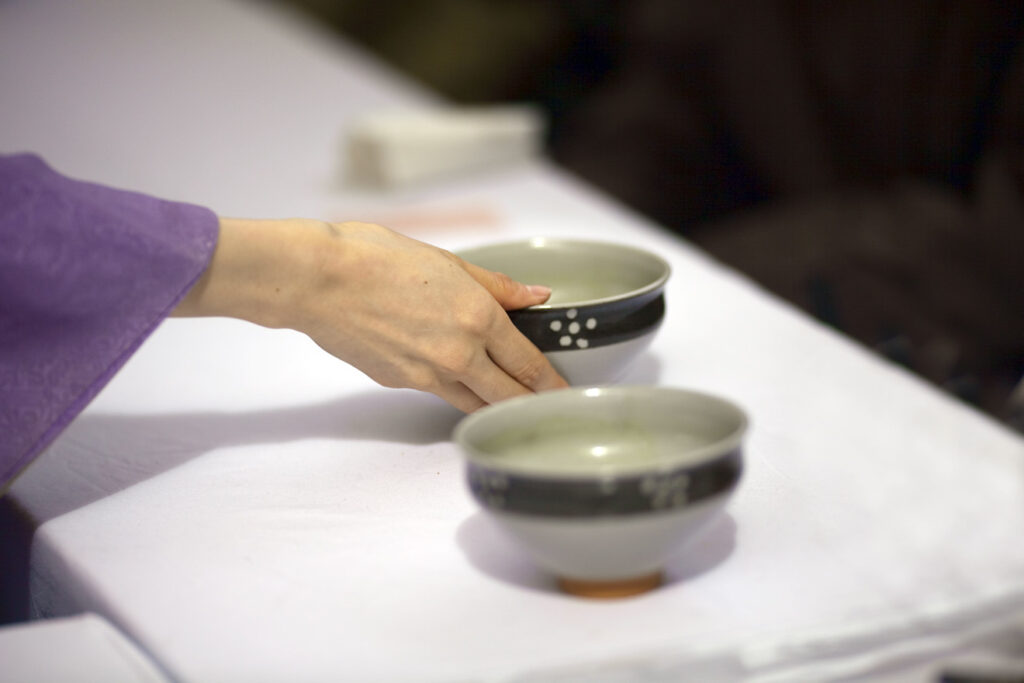In non-Covid times, on the 25th of February it is Baikasai Plum Blossom Festival in the Kitano Tenmangū Shrine in Kyoto. One of the main events of this festival is an outdoor tea ceremony. But what exactly does “tea ceremony” mean?
In two guest blogs, Klara and Philo help you to learn more about this special tradition. And when COVID is over, the Japan Fans Utrecht will organise workshops & demonstrations of various tea ceremonies at their two locations.

As the Japan Fans Utrecht wish to form friendship bonds with people from all over the world who take an interest in Japan, we are very happy to announce that this first guest blog was written by a Japan Fan from Croatia. Klara already graduated in Japanese Language and Culture from the universities of Pula (Croatia) and Kyoto (Japan) and is eager to continue her studies. “For the past few years my biggest passion is the Japanese language and culture. I learned a lot, I want to learn more and I want to share my knowledge to other people!”
Tea Ceremony
The Japanese tea ceremony (known as 茶道 sadō/chadō, “The Way of Tea”) or 茶の湯 cha-no-yu) is a ceremonial way of preparing and drinking green tea typically in a traditional tearoom with tatami floor. It is counted as one of the three classical Japanese arts of refinement, along with kōdō for incense appreciation, and kadō for flower arrangement.
History
Tea was introduced to Japan in the 8th century from China and was drunk as a medicinal beverage mainly amongst priests and the upper class and the bowls and utensils are an ancient art form that in some cases preceded even the connection to China.
It was not until the Muromachi Period (1333-1573) that 茶会 (chakai) gained popularity among people of all social classes. Among the affluent members of society, tea drinking parties became popular in which participants would show off their exquisite tea bowls and display their knowledge about tea. Around the same time, a more refined version of tea parties developed with Zen-inspired simplicity and a greater emphasis on spirituality. It is from these gatherings that the tea ceremony has its origins.
The father of the modern way of tea was Sen no Rikyu (1522-1591) who advocated an austere, rustic simplicity. Most of today’s schools of tea ceremony, including Omotesenke and Urasenke, developed from his teachings.

Equipment
The equipment for tea ceremony is called chadōgu (茶道具). A wide range of chadōgu are available and different styles and motifs are used for different events and in different seasons, with most being constructed from carefully crafted bamboo. All the tools for tea are handled with exquisite care, being scrupulously cleaned before and after each use and before storing, with some handled only with gloved hands.
⦁ Chakin (茶巾) = small rectangular white linen or hemp cloth mainly used to wipe the tea bowl
⦁ Tea bowl (茶碗 chawan) = they are available in a wide range of sizes and styles, and different styles are used for thick and thin tea. Bowls over four hundred years old are in use today, but only on unusually special occasions.
⦁ Tea caddy (棗・茶入, Natsume・Chaire) = small lidded container in which the powdered tea is placed for use in the tea-making procedure (お手前; お点前; otemae).
⦁ Tea scoop (茶杓 chashaku) =they are generally carved from a single piece of bamboo. Different styles and colours are used in various tea traditions.
⦁ Tea whisk (茶筅 chasen) = this is the implement used to mix the powdered tea with the hot water. Tea whisks are carved from a single piece of bamboo. There are various types. Tea whisks quickly become worn and damaged with use, and the host should use a new one when holding a chakai or chaji.

The Ritual
Tea gatherings are classified as either an informal tea gathering (茶会 chakai “tea gathering”) or a formal tea gathering (茶事 chaji “tea event”). A chakai is a relatively simple course of hospitality that includes confections, thin tea, and perhaps a light meal. A chaji is a much more formal gathering, usually including a full-course kaiseki meal followed by confections, thick tea, and thin tea. A chaji may last up to four hours.
But whether chakai or chaji, the ceremony takes place in a small room or tea house that is specially designed for the ceremony. Laid out on a square of exactly four and a half tatami mats, around a sunken brazier on which the water is boiled, the elegant choreography of the chakai or chaji proceeds at a pace that allows host and guests alike to savor the moment.
The whole ceremony is design to focus the attendees’ attention on the process itself, on the utensils and tea bowls, which are admired and even passed around carefully, as they are objects of great reverence. Special, elegant cloths are used to clean each one, and in some cases, even to hold them.
Bowls of tea are shared – beginning with thin (usucha) tea, then with the thicker (koicha) tea, ritually whipped into a gorgeous green froth, then passed ritually from one guest to another. The tea and its qualities are discussed as the tea itself is deeply enjoyed. Presence is focused to a degree that can only be called meditative.
